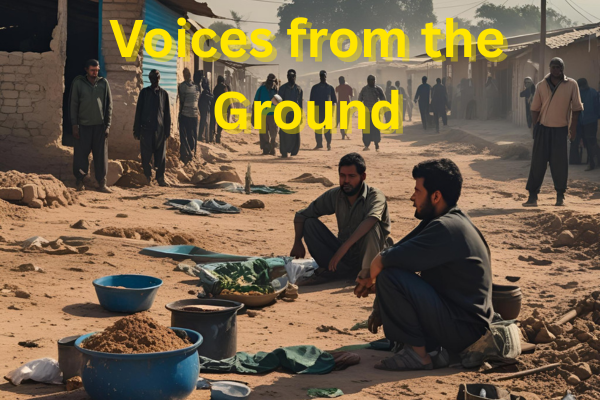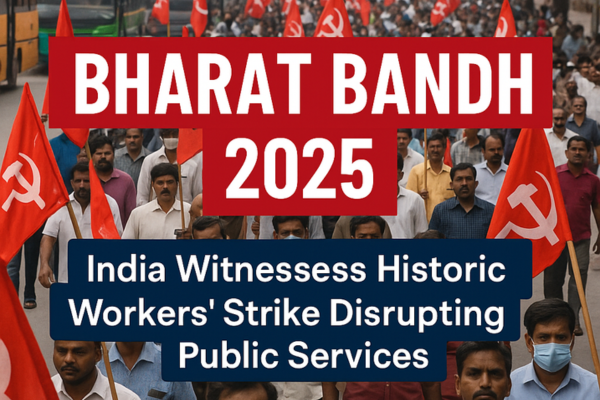Introduction
On July 9, 2025, Bharat Bandh 2025 shook the nation as over 250 million workers from 10 central trade unions—supported by farmers and rural laborers—launched a massive nationwide strike. The scale and scope of this action have made Bharat Bandh 2025 one of the largest general strikes in India’s history. In this comprehensive post, we analyze the causes behind Bharat Bandh 2025, its impact on essential sectors, political reactions, historical parallels, and what it means for the country’s future.
Table of Contents
Why Bharat Bandh 2025 Was Called?
Policy Concerns
The unions argue that the government’s recent labor reforms and deregulation favor big businesses at the cost of worker welfare—fueling the demand for a nationwide shutdown under the banner of Bharat Bandh 2025.
Land and Agriculture Issues
Farm groups backing Bharat Bandh 2025 cite unfair compensation policies and worries over privatization of agricultural land and services.
Inflation and Cost of Living
Rising costs have added pressure to maintain fair wages—another primary grievance behind Bharat Bandh 2025.
Unions’ Collective Action
The convergence of labor and farmer groups during Bharat Bandh 2025 amplified its nationwide reach and political resonance.
Which Sectors Were Hit by Bharat Bandh 2025?
The scale of All-India Bandh 2025 was unprecedented:
- Banking & Financial Services: Services were largely halted, impacting both urban and rural regions.
- Railways & Transportation: Shutdowns of major rail routes and delays in bus services left travelers stranded.
- Postal & Insurance Services: Postal deliveries and insurance operations saw near-total disruption.
- Coal & Mining: Power generation was affected by halted mining operations.
- Education & Healthcare: Schools, colleges, and public hospitals functioned minimally.
Public and Political Reaction to Bharat Bandh 2025
Citizens
Urban commuters faced significant delays in trains, buses, and subways.
Rural areas reported work stoppages in local markets.
Many voiced support for All-India Bandh 2025, while others complained of inconvenience and disruption.
Government and Opposition
- Central Government defended its policies, stating they balance growth with social welfare without responding directly to the bandh.
- Opposition Parties praised Bharat Bandh 2025, using the event as a platform to criticize “pro‑corporate” reforms.
Historical Context: Bharat Bandh 2025 in Perspective
India has a long history of general strikes:
- 1974: A massive strike involved over 60 million workers demanding better wages and worker rights.
- 2019: Another Bharat Bandh impact saw about 250 million participants protesting labor reforms.
- Bharat Bandh 2025, involving 250 million+ participants, ranks among the largest economic shutdowns tied to civic protest in India’s history.
Media Coverage and Public Sentiment on Bharat Bandh 2025
National and local media provided live updates from major cities:
- Delhi, Mumbai, Kolkata: Majority of banks and transit services shut down.
- State Capitals: Mixed impact, with rural and urban regions showing varied compliance.
- Social media amplified both criticism and support—hashtags like #BharatBandh2025 and #BandhDekho peaked on major platforms.
Impact Assessment of Bharat Bandh 2025
Economic Fallout
Daily GDP Loss: Estimated at ₹8,000–10,000 crore due to stalled commerce.
Business Disruption: MSMEs suffered the most due to halted services.
Agriculture: Farmers shifted to protest participation, lowering daily agricultural productivity.
Social and Political Shifts
- High public mobilization may lead to renewed negotiations on labor and agricultural policies.
- Pressure on the government to launch welfare measures or reverse certain reforms.
Public Reaction to Bharat Bandh 2025: Voices from the Ground

The nationwide strike known as Bharat Bandh 2025 has ignited a wave of mixed reactions across the country. Called by a coalition of farmers’ unions, labor organizations, and opposition political parties, the bandh aimed to protest against a range of pressing issues including inflation, unemployment, agrarian distress, and privatization of public assets. As roads went silent, markets shuttered, and public transport came to a halt in many parts of India, people across the spectrum voiced their opinions — some in strong support, others in deep frustration.
The Pulse of the Common People
In metropolitan cities like Delhi, Mumbai, and Bengaluru, the bandh disrupted daily life for lakhs of people. While many citizens understood the purpose behind the protest, the inconvenience it caused sparked a flurry of debates online and offline.
Ramesh Singh, a daily wage laborer from Ghaziabad, said, “I understand why they are doing Bharat Bandh 2025, but for people like me who earn every day to eat every day, a strike is a disaster. I lost a full day’s income.”
Others, particularly in the middle and upper-middle classes, expressed a sense of solidarity. Anita Mehra, a school teacher from Pune, shared on social media: “The inconvenience is real, but so is the crisis. Bharat Bandh 2025 is a wake-up call. The voices of farmers and workers matter too.”
Small Businesses: Between Support and Survival
The bandh hit small businesses the hardest. In cities and towns across Punjab, Maharashtra, and Tamil Nadu, shopkeepers voluntarily closed their shutters in support of the cause — especially in regions where farmer unions hold strong influence. However, not everyone was on board.
Manoj Patel, who runs a stationery shop in Surat, expressed concern: “I am sympathetic, but I have EMIs and rent to pay. We lose sales and customers when the country shuts down.”
At the same time, many business owners aligned with the movement, stating that the long-term issues raised by Bharat Bandh 2025 — particularly inflation and privatization — would hurt them more if left unchecked.
Political Divide
As with most national protests, the Bharat Bandh 2025 also became a battleground for political messaging. Opposition parties were quick to amplify the voices of protestors, attending rallies and releasing statements of support.
Priyanka Rao, a youth leader from a left-leaning student organization, said: “The bandh represents the frustration of everyday Indians who feel ignored. Bharat Bandh 2025 is not just a strike; it’s a symbol of collective unrest.”
On the other hand, some members of the ruling party dismissed the bandh as politically motivated. A BJP spokesperson noted, “Disrupting the economy and daily life is not the way forward. Dialogue is the democratic method, not bandh politics.”
This political divide further fueled debates on television panels, WhatsApp groups, and Twitter threads.
Farmers and Labor Unions: The Driving Force
At the heart of Bharat Bandh 2025 were the farmers and labor unions who have consistently voiced their concerns over the years. High input costs, lack of MSP guarantees, and continued unemployment post-COVID-19 were among the major concerns highlighted.
Charan Das, a farmer from Haryana, participated in a local protest and said, “If we don’t raise our voice now, who will listen? Bharat Bandh 2025 is our only tool to make the system notice our pain.”
Similar sentiments were echoed by factory workers and gig economy workers who joined the protest. In many cases, participation was peaceful and symbolic — through roadblocks, chakka jams, and silent marches.
Youth and Social Media: A Divided Front
Young Indians took to social media to both support and criticize Bharat Bandh 2025. Platforms like X (formerly Twitter), Instagram, and YouTube were flooded with hashtags such as #BharatBandh2025, #BandhKeSideEffects, and #IndiaShutsDown.
Many students and young professionals highlighted the issues raised by the bandh, particularly unemployment and education costs. However, others expressed frustration at missed classes, cancelled exams, and travel disruptions.
One viral post summed up the generational divide: “Our parents fought for jobs. We’re fighting just to get one. Bharat Bandh 2025 is frustrating, but it’s also necessary.”
Law and Order: Mixed Reviews
While some parts of the country reported peaceful participation, sporadic incidents of vandalism and forced closures were reported in states like West Bengal and Uttar Pradesh. Police presence was increased in sensitive zones, and Section 144 was imposed in select districts.
Authorities managed to contain most of the unrest, but the perception of force being used in some areas drew criticism from human rights groups.
What’s Next After Bharat Bandh 2025?
Negotiation Tables
Union leaders have signaled willingness to discuss reforms, opening the door for potential policy revisions post-Bharat Bandh 2025.
Future Bandhs or Strikes
If perceived as ineffective, unions have threatened deeper disruptions.
Government Response
Plans for relief measures—such as subsidies, wage hikes, or policy reassessment—are being discussed in Parliament.
Public Opinion
Citizen sentiment post-Bharat Bandh 2025 will significantly influence political postures and policy adjustments.
5 Key Takeaways from Bharat Bandh 2025
| Insight | Details |
|---|---|
| Scale | Over 250 million participants—among the largest general strikes in India’s history. |
| Multisectoral Impact | Shutdowns in finance, transport, education, healthcare, and mining. |
| Political Power Play | Opposition leveraged the Bandh to challenge government policy. |
| Economic Costs | Daily losses estimated in thousands of crores INR. |
| Potential for Change | Opens pathways for dialogue and reform adjustments. |
Conclusion:
Regardless of where one stands on the spectrum, Bharat Bandh 2025 cannot be ignored. It brought to the forefront a host of systemic issues — from farmer distress to youth unemployment, and from economic inequality to political accountability.
Public reaction, though polarized, reflected a growing anxiety about India’s future. For some, it was a call for justice. For others, a disruption. But for all, it was a moment that demanded attention, introspection, and — above all — action.
Bharat Bandh 2025 is a landmark event in India’s civil and labor history—massive in participation, wide in impact, and potent in political symbolism. For your blog Current Pulse Jay, this topic offers rich ground for analysis, SEO traction, and audience engagement. You can conclude with open-ended questions like: “What future policy shifts could emerge from Bharat Bandh 2025?” to drive comments and shares.


It is a grate awareness for Indian people..